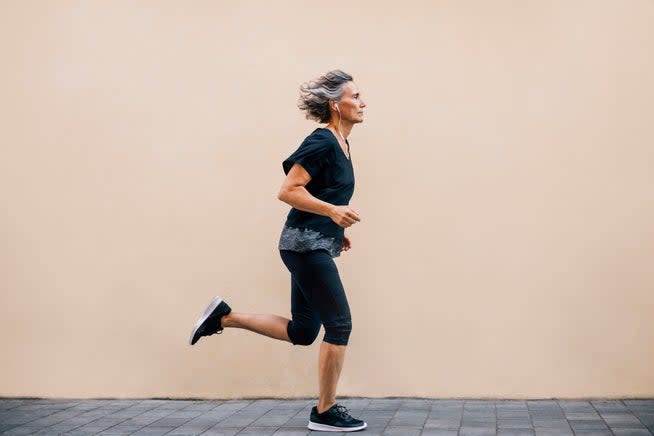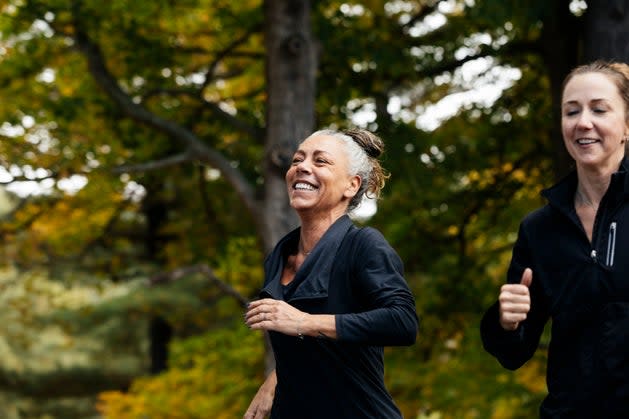8 Strategies to Train and Race Through Menopause
The last decade has seen women over 40 taking endurance sports by storm. In a report by the Washington Post (which cited Running USA, US Masters Swimming, and Ironman), the number of 40-year-old and older women lining up for running races grew by 1 million between 2010 and 2015; 40-plus women who say they workout with a swim team like a Master's group increased by 30 percent over about the same period; and women 40-plus registering for Ironmans more than doubled from 4,000 in 2010 to 10,600 in 2016. Makes sense. Members of the Title IX generation, who were the first to swarm sports fields as young girls and women, are now the first to charge into midlife with no intention of slowing down. They're also the first athletes to be toeing the line en masse during menopause.
And the medical community isn't ready for us. A 2019 study reported that of 177 resident physicians surveyed in family medicine, internal medicine, and even ob/gyn, 20% received zero lectures on menopause during their training. Less than 7% reported feeling prepared to help manage the care of women through their menopausal years.
If our doctors aren't prepared to help us through the transition, it's little surprise that our coaches may not know how to help us manage symptoms through training and racing--or even understand what our symptoms are. The result: Many menopausal athletes stay silent or drop out. When you look at the precipitous decline in female numbers after 50, it begs the question: Are unaddressed menopause symptoms at least partly to blame?
Time to change that. In 2020, there's no reason to slow down or stop just because your periods are. Here's a look at how the hormonal shifts that come during your menopausal years affect your training and racing--and what to do about it.
Menopause in Athletes: 8 Key Strategies
What Changes During "The Change"
In a nutshell, over time your ovaries begin releasing fewer eggs in less regular intervals and you experience hormone imbalances where your estrogen and progesterone levels rise and fall unevenly. This typically occurs in your mid-40s, but it can happen as early as the mid- to late-30s.
These hormones help regulate a massive amount of metabolic functions including temperature control, mood, appetite, muscle and bone building and recovery, connective tissue strength, body composition, blood sugar control, heart rate variability, and more. When they start going haywire, so can your training, racing, and general sense of well being. Here's what can help:
Keep Your Cool
It becomes harder to handle the heat during this time of hormonal flux. "Your blood vessels aren't as quick to dilate and send blood to your skin to cool you down and you sweat later," said exercise physiologist and nutritionist Stacy Sims, Ph.D., author of ROAR and creator of The Menopause for Athletes Course. "That means you get more heat trapped in your core. And when your core is hot, you slow down."
Hydration is key. If you're going to be training in the heat, prehydrate with a sodium-rich drink beforehand. Drain at least a bottle an hour while riding and grab a protein-rich recovery drink when you're done.
Cooling yourself before your hot weather session by draping a cold towel over your neck can also help. Drink ice-cold fluid during your workout if you can. Afterwards, dunk yourself in a cold bath or pool to push blood out of your extremities and into your central circulation to cool down and speed recovery.
RELATED: How To Race On Your Period
Eat Enough!
Menopause brings body composition changes. "Some weight gain is normal during menopause," said Mary Jane Minkin, M.D., clinical professor in the Department of Obstetrics, Gynecology, and Reproductive Sciences at the Yale University School of Medicine and creator of the women's health resource madameovary.com. "You may do everything right and you may still gain five pounds."
Starving yourself during this time will not help. In fact, it may make it a lot worse, Sims said. "Our hormone changes also elevate our levels of the stress hormone cortisol, which encourages weight gain, especially in our abdominal area."
Eating less--especially as an active athlete in menopause--will only drive up your stress hormones and make weight harder to lose and easier to gain. Instead, focus on eating nutritionally-dense, whole foods and eat enough to fuel your workouts and recovery, Sims said.

Be Choosier About Carbohydrates
Estrogen helps insulin do its job shuttling blood sugar into cells. As it diminishes, you become more insulin resistant and more sensitive to carbs, Sims said. That means you're more susceptible to blood sugar swings and need fewer carbohydrates overall.
"Save the simple sugars and starchy carbs for when you really need them during races and training. Otherwise, get your carbs from fruits and vegetables," Sims said. "Aiming to get about 30 grams of carbohydrate--about the amount in one banana--during long endurance training sessions will generally be sufficient."
Pump Up Protein
As your sex hormones decline, you become less sensitive to the muscle-making stimulus of protein in your diet. That not only makes it harder to build and maintain muscle, but also to recover from hard workouts. That means you need to make sure to get plenty of protein, time your protein correctly, and make the protein you consume high-quality.
After any hard exercise session, get at least 25 grams of protein within 30 minutes if you can, Sims said. Your cortisol levels are elevated after a tough exercise session and that makes you catabolic--you're literally eating your muscles for energy. Protein helps bring down the cortisol and promotes repair. Just skip the soy shakes, Sims said. "Soy protein can help lower cortisol, but it doesn't help for muscle synthesis. Choose a recovery food or drink with whey and casein for the best results." Good choices include Greek yogurt or cottage cheese.
Turn Up the Intensity
Everyone loves a good, long Zone 2 run. But because your body is more resistant to responding to training stimulus as your hormones decline, you need to be sure to include hard sessions to get the same results. That means really sharp, high-intensity sprint interval work like Tabata intervals, Sims said. Intensity also improves body composition. "Research shows that this type of training decreases visceral fat, increases lean mass, and improves cardiovascular fitness more effectively than longer HIIT sessions or steady-state endurance work."
Likewise, make sure you bring that intensity to the weight room and lift heavy weights. "Our bodies need additional exercise stress to make up for the muscle-making stimulus our hormones, like estrogen, used to provide," Sims said. "That means not lifting light weights for 20 reps, but rather lifting heavy weights in the low three to six repetition range to really build that lean mass and maintain muscle integrity."

Work Your Core--And Pelvic Floor
Nearly half of women over 50 say they sometimes leak urine, according to a National Poll on Healthy Aging. Even if you're okay with peeing on the bike during a big race, occasional urinary incontinence can make training and racing a real drag.
You've likely heard that it's important to strengthen your pelvic floor muscles with Kegel exercises (where you clench your pelvic muscles like you're trying not to pee). But did you know that the pelvic floor is actually part of the core, and works in collaboration with the diaphragm, multifidus, and transversus abdominis (TrA) muscles? A weak core can also contribute to incontinence, said Chloe Murdock, PT, DPT, OCS, CSCS.
Weakness or tightness in any part of the core, such as the TrA, which is the deepest layer of abdominal muscles that wrap around the front and sides of your torso like a corset, can force your pelvic floor muscles to saddle more work than they can handle and lead to leaking, Murdock said.
A simple way to check if your TrA is working is to do a forearm plank and see if you can keep your lower abdominal muscles flat, or if they "dome" downwards. This doming is an indication that the TrA is not working well, and the superficial muscles are taking over instead. In this case, you should modify the exercise to make it easy enough that you can keep the lower abdomen flat. This can be done by keeping your knees on the floor, or doing the plank at an incline with your arms on the edge of a couch, for example.
RELATED: The Uncertainty Of Aging And Athletics
Adopt Smart Sleep Strategies
The hot flashes, night sweats, and general anxiety that come with the hormonal fluctuations of menopause can wreak havoc on your sleep. That's especially bad for athletes, because sleep time is recovery time.
To help your body cool down and get ready for a good night's sleep, Sims recommended drinking a cold glass of melatonin-boosting tart cherry juice 30 minutes before bed.
Also avoid eating within two hours of bed, Sims advises. "Making your body work on digestion interferes with the parasympathetic needs of sleep. So have your last meal earlier to give yourself plenty of time to digest so you can get proper rest."
Talk to Your Doctor about Menopause
Finally a gynecologist can help balance out your hormones as an athlete in menopause and ease you through the transition with far less upheaval, Minkin said. "Low-dose birth control pills can be a blessing during perimenopause. The progestin helps with heavy periods. And they have low amounts of estrogen, which can help hot flashes, night sweats, sleep disruptions, and all those other symptoms."
To find a doctor who specializes in menopause, check out menopause.org.
Read more about the mature athlete in our series on athletes and aging.
Selene Yeager is a NASM certified personal trainer, USA Cycling certified coach, Pn1 certified nutrition coach, and cyclist and Ironman athlete. She's also the host of the menopause in athletes-focused podcast "Hit Play, Not Pause."

